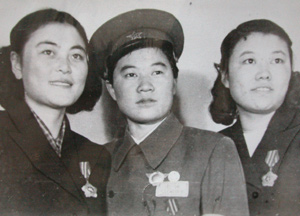|
Woman tractor driver breaks new ground
(China Daily)
Updated: 2004-03-23 08:50
At 73, Liang Jun still has a booming resonance in her voice and a hearty
laugh.
Already retired for 14 years, she lives a relaxed life in an old apartment
building in Harbin, the capital of Northeast China's Heilongjiang Province. The
furnishing in the old apartment is almost Spartan, old but very clean.

Liang Jun, 73,
holds a RMB one-yuan note, which features her driving a tractor. [China
Daily] | She says her days follow a pretty regular
routine, which includes reading newspapers in the morning and watching
television in the afternoon.
But the routine in her life that is not the least bit like routine, but that
she absolutely never misses is going to the rehearsals of the Harbin Women Model
Workers' Chorus.
"I don't feel old when I sing the old songs," said Liang.
The old songs were those popular in the 1950s. And the old songs bring back
those earlier days of the People's Republic, when young women like Liang made
history by entering professions and trades that no Chinese women had ever
ventured into before.
Liang was the first woman in China to drive a tractor - a Hotbull Lanz model
manufactured in Germany.
Born in 1931 into a poverty-stricken peasant family, Liang was sent to live
and work in a nearby landlord's family as a child bride when she was 12.
Before she went, she made a daring request of her new family: She wanted to
go to school. "I believed that I wouldn't get bullied if I learned to read and
write," she recalled.
Her dream was fulfilled in May 1947, when Heilongjiang came under the rule of
the Communist government. The new local people's government opened a teacher's
school in Dedu County where she lived. Children from poor families, including
Liang, were enrolled.

Liang Jun (right)
poses for a picture whith Guo Junqing and Tian Guiying in 1950. [file
photo] | It was a work-study school, with the
students tilling the land during farming season and attending classes in the
slack seasons. In those days, she had time to read novels and watch films, some
of them by the Soviet writers and directors.
She said she remembers one Soviet film better than all the others, one
featuring a woman protagonist who learned to drive a "fire plough," which was
the local nickname for a tractor.
"Her name was Basha. When World War II broke out, her husband and children
were killed by the German army. She then drove a tank, using the skills she
learned driving a tractor, and led the villagers in the fight against the
Germans," Liang recalled. "I was deeply moved by her courage."
In February 1948, the school decided to send three students to a
tractor-driver training school nearby. Liang persuaded the principal of the
school to let her go.
When she and the two boys also chosen arrived at the training school after
walking 50 kilometres, the head of the training school was surprised to see
Liang.
Liang clearly remembers their encounter that day and his first words: "What
are you doing here? How can you, a girl, learn to drive a tractor?"
She answered him: "Why not? Men and women are the same. Let me try." She
further recalls saying to him that he could always ask for a replacement if she
didn't work out.
So Liang stayed. She was the only woman trainee in a class of 70 students.
She was attentive and worked hard, and in two months she not only learned how
to drive the "fire plough," but to repair it as well.
She was wildly happy every time she climbed on the Hotbull Lanz and drove it.
News about this first Chinese woman tractor driver soon spread and Liang
became a role model for many aspiring young women like herself.
On March 8, 1950, Tian Guiying, daughter of a poor family that made their
living by fishing, became the first woman in China to drive a railroad
locomotive, on the line between Dalian and Lushun, in Northeast China's Liaoning
Province. Tian was the head of an all-women train crew for more than 30 years.
Two years later on the same day (March 8, 1952), a squadron of women pilots
teamed up to fly over Tian'anmen Square. The 26 women were the first women to
get their pilots' wings in China.

Liang Jun poses for
a picture by a farming machine. [file
photo] | By 1953, only four years after New
China was founded, women were already in charge of electric power generators,
iron and steel furnaces and rail transportation facilities. Some factory
managers were women.
Before 1949, only a tiny percentage of women were employed in such
professions.
But by 1958, 8.1 million women had permanent professional or industrial jobs
in government, educational and scientific institutions, hospitals, and in
transportation, postal and other sectors, quadrupling the figure of six years
earlier.
In June 1950, Liang organized an 11-member women's tractor team to work on
the farm.
In 1951, she came to Beijing for further study of agricultural machinery.
Upon graduating with a college degree in the mid-1950s, she worked first as
an engineer, then headed a number of factories making or repairing farming
machines.
In May 1990, she retired. She has three sons and celebrated her golden
wedding last year.
Though she lives in relative obscurity nowadays, her name is a part of the
history of the People's Republic.
In 1958, the People's Bank of China had the third set of renminbi (RMB)
banknotes designed. The one yuan denomination features a woman tractor driver,
an engraving based on an photographic image of Liang. The set of RMB banknotes
is now much sought after by collectors, as it has largely been withdrawn from
circulation.
| |
 |
|
 |
|
|
Today's
Top News |
|
|
|
Top Life
News |
 |
|
 |
|
|
|
|
|
|


